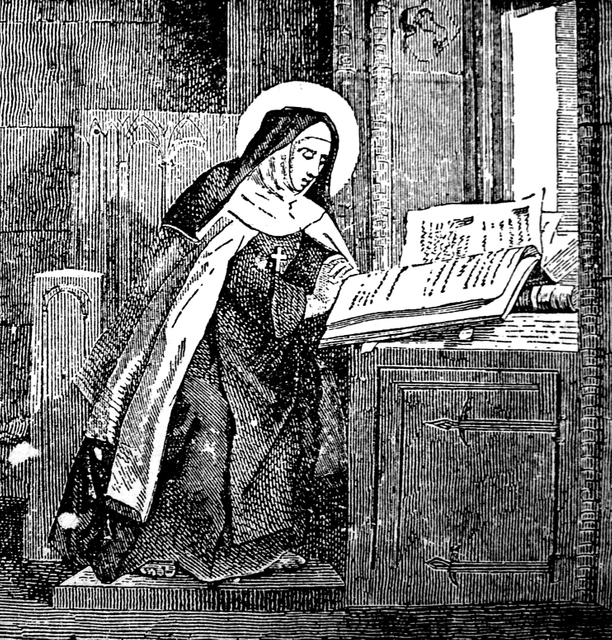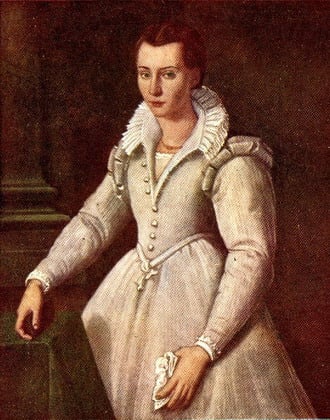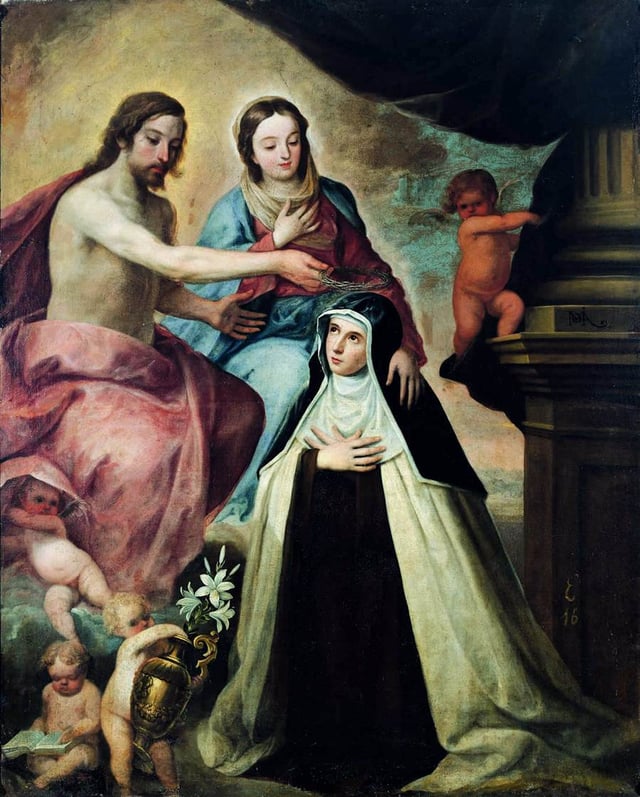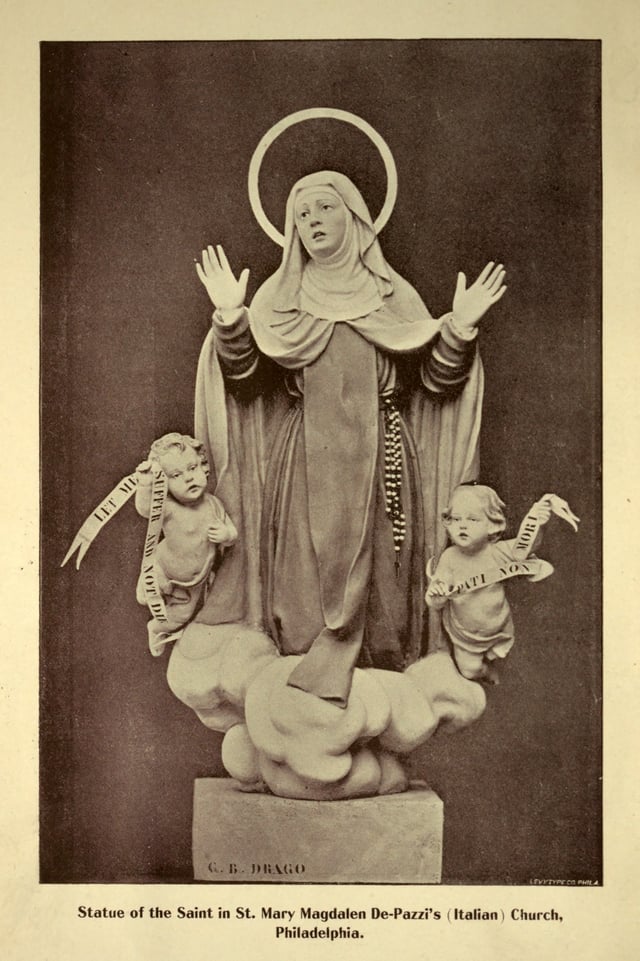Mary Magdalene de' Pazzi

Mary Magdalene de' Pazzi

Saint Mary Magdalene de' Pazzi, O.Carm. | |
|---|---|
| Virgin | |
| Born | Caterina de' Pazzi April 2, 1566 Florence, Duchy of Florence |
| Died | May 25, 1607(1607-05-25)(aged 41) Florence, Grand Duchy of Tuscany |
| Venerated in | Roman Catholic Church |
| Beatified | 1626, Rome, Papal States, by Pope Urban VIII |
| Canonized | April 28, 1669, Rome, Papal States, by Pope Clement X |
| Major shrine | Monastery of Santa Maria Maddalena de' Pazzi, Careggi, Florence, Italy |
| Feast | May 25 (May 29 from 1728 to 1969) |
| Patronage | against bodily ills; against sexual temptation; against sickness; sick people; Naples (co-patron) |

St. Mary Magdalene de' Pazzi at age 16 by Santi di Tito (1583)

Vision of Saint Mary Magdalene de' Pazzi by Pedro de Moya (ca. 1640)

Statue of the Saint in St Mary Magdalen De' Pazzi Italian Church, Philadelphia (1900)
Saint Mary Magdalene de' Pazzi, O.Carm. (Italian: Maria Maddalena de' Pazzi; April 2, 1566 – May 25, 1607) was an Italian Carmelite nun and mystic. She has been declared a saint by the Roman Catholic Church.
Saint Mary Magdalene de' Pazzi, O.Carm. | |
|---|---|
| Virgin | |
| Born | Caterina de' Pazzi April 2, 1566 Florence, Duchy of Florence |
| Died | May 25, 1607(1607-05-25)(aged 41) Florence, Grand Duchy of Tuscany |
| Venerated in | Roman Catholic Church |
| Beatified | 1626, Rome, Papal States, by Pope Urban VIII |
| Canonized | April 28, 1669, Rome, Papal States, by Pope Clement X |
| Major shrine | Monastery of Santa Maria Maddalena de' Pazzi, Careggi, Florence, Italy |
| Feast | May 25 (May 29 from 1728 to 1969) |
| Patronage | against bodily ills; against sexual temptation; against sickness; sick people; Naples (co-patron) |
Life
De' Pazzi was born at Florence, Italy, on April 2, 1566,[1] to Camillo di Geri de' Pazzi, a member of one of the wealthiest and most distinguished noble families of Renaissance Florence, and Maria Buondelmonti. She was christened Caterina, but in the family was called Lucrezia, out of respect for her paternal grandmother, Lucrezia Mannucci.[2]
At the age of nine de' Pazzi was taught how to meditate by the family chaplain, using a then-recently-published work explaining how one should meditate on the Passion of Christ. Years later, this book was one of the items she brought with her to the monastery.[2] She received her First Communion at the then-early age of 10 and made a vow of virginity one month later. She experienced her first ecstasy when she was only twelve, in her mother's presence. From then on, she continued to exhibit what she considered to be many varied mystical experiences.
In 1580, at age fourteen, de' Pazzi was sent by her father to be educated at a monastery of nuns of the Order of Malta, but she was soon recalled to wed a young nobleman.[1] Caterina advised her father of her vow, and he eventually relented and allowed her to enter monastic life. She chose the Carmelite monastery of Santa Maria degli Angeli in Florence because the rule there allowed her to receive Holy Communion daily. In 1583 she was accepted as a novice by that community,[2] and given the religious name of Sister Mary Magdalene.[1]
Mystic
De' Pazzi had been a novice for a year when she became critically ill. Upon receiving the religious habit, one of the sisters asked her how she could bear so much pain without a murmur. Mary pointed to the crucifix and said:[3]
Those who call to mind the sufferings of Christ, and who offer up their own to God through His passion, find their pains sweet and pleasant.
As a safeguard against deception and to preserve the revelations, the de' Pazzi confessor asked her to dictate her experiences to her fellow nuns. Over the next six years, five large volumes were filled. The first three record ecstasies from May 1584 through Pentecost week of the following year. That particular week was a preparation for a severe five-year trial that she relates. The fourth book records that trial, and the fifth is a collection of letters concerning reform and renewal. Another book, Admonitions, is a collection of her sayings arising from her experiences in the formation of women in religious orders.[5]
It was believed that de' Pazzi could read the thoughts of others and predict future events. For instance, during one ecstatic event she predicted the future elevation to the papacy of Cardinal Alessandro de' Medici (as Pope Leo XI).[6] During her lifetime, she allegedly appeared to several persons in distant places and cured a number of sick people.[5]
Veneration
Numerous miracles allegedly followed de' Pazzi's death, and the process for her beatification was begun in the year 1610 under Pope Paul V, and completed under Pope Urban VIII in the year 1626. She was not, however, canonized until 62 years after her death, when Pope Clement IX raised her to the altars on April 28, 1669. The church of the Monastery of Pažaislis, commissioned in 1662 in Lithuania, was one of the first to be consecrated in her honor.
The saint herself is little known outside Italy, but her cult is very strong, especially in Florence. Paulist Press issued a selection of her writings in English translation in their series of Classics of Western Spirituality.[7] Her importance in the Mission to the East especially in connection with India is recently explored.[9]
Feast day
In 1670, the year after de' Pazzi's canonization, the feast day of the saint was inserted in the General Roman Calendar for celebration on May 25, the day of her death. In 1728, the date of May 25 was assigned instead to Pope Gregory VII, and her feast day was moved to May 29, where it remained until 1969, when it was restored to its original place in the calendar, as the true anniversary of her death.[10][11]
Mental health
See also
Carmelite Rule of St. Albert
Book of the First Monks
